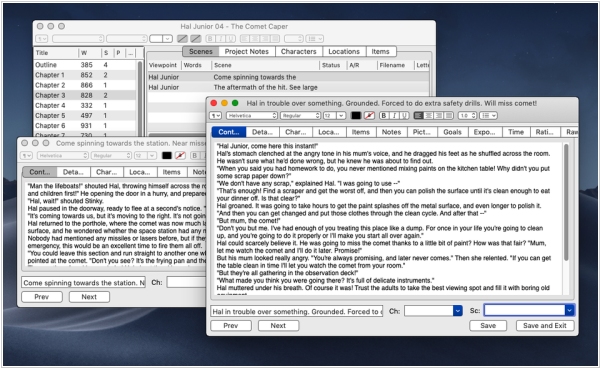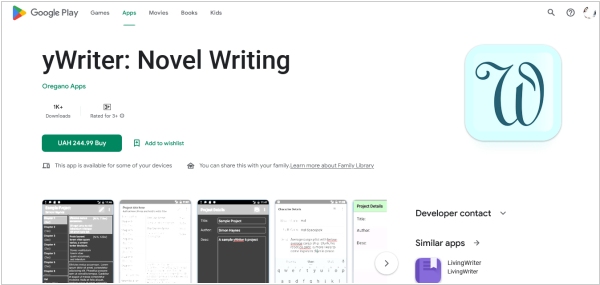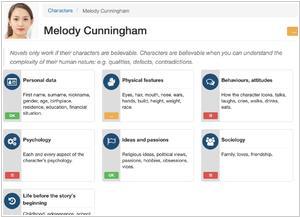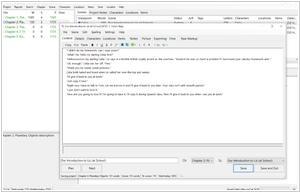bibisco vs yWriter
Last updated: July 20, 2023
Bibisco and yWriter are two popular writing software tools designed to assist authors in organizing and developing their writing projects, particularly novels and longer works. While they share similarities in aiding the writing process, they have some key differences in their features and approach.
1. User Interface and Organization: One of the primary differences between Bibisco and yWriter lies in their user interfaces and organizational systems. Bibisco offers a user-friendly and visually appealing interface that focuses on guiding writers through the creative process step by step. It emphasizes character development, story arcs, and thematic elements, helping authors dive deep into their characters' motivations and relationships. On the other hand, yWriter provides a more structured approach, breaking down the story into chapters and scenes, with a focus on word count and project statistics to track progress efficiently.
2. Writing Tools and Story Planning: Another important distinction is their approach to writing tools and story planning. Bibisco stands out for its in-depth character and setting development tools, making it ideal for authors who want to fully explore their characters' backgrounds and settings before diving into the writing process. It encourages writers to delve into their characters' emotions, psychology, and past experiences, leading to well-rounded and believable characters. Conversely, yWriter might be more suited for authors who prefer a straightforward approach to story planning and outlining, providing an efficient way to organize scenes and chapters without as much emphasis on character depth.
3. Platform Compatibility and Availability: Bibisco and yWriter differ in terms of their platform compatibility and availability. Bibisco is known for its cross-platform support, being available on macOS, Windows, and Linux, ensuring writers can access their projects seamlessly across different devices. In contrast, yWriter is primarily designed for Windows, which might limit its accessibility for writers who prefer other operating systems.
1. User Interface and Organization: One of the primary differences between Bibisco and yWriter lies in their user interfaces and organizational systems. Bibisco offers a user-friendly and visually appealing interface that focuses on guiding writers through the creative process step by step. It emphasizes character development, story arcs, and thematic elements, helping authors dive deep into their characters' motivations and relationships. On the other hand, yWriter provides a more structured approach, breaking down the story into chapters and scenes, with a focus on word count and project statistics to track progress efficiently.
2. Writing Tools and Story Planning: Another important distinction is their approach to writing tools and story planning. Bibisco stands out for its in-depth character and setting development tools, making it ideal for authors who want to fully explore their characters' backgrounds and settings before diving into the writing process. It encourages writers to delve into their characters' emotions, psychology, and past experiences, leading to well-rounded and believable characters. Conversely, yWriter might be more suited for authors who prefer a straightforward approach to story planning and outlining, providing an efficient way to organize scenes and chapters without as much emphasis on character depth.
3. Platform Compatibility and Availability: Bibisco and yWriter differ in terms of their platform compatibility and availability. Bibisco is known for its cross-platform support, being available on macOS, Windows, and Linux, ensuring writers can access their projects seamlessly across different devices. In contrast, yWriter is primarily designed for Windows, which might limit its accessibility for writers who prefer other operating systems.
13
bibisco is the perfect companion for your novel writing journey. bibisco provides all the features and tools you need to draft, refine, and share your story with ease. With its distraction-free editor, comprehensive novel analysis, and world-building features, you can create a captivating story from start to finish.
9
Free novel-writing software designed by veteran author and programmer, Simon Haynes. yWriter helps you to write a book by organising chapters, scenes, characters and locations in an easy-to-use interface.
bibisco vs yWriter in our news:
2021. yWriter - free software for novel writers

yWriter is a useful program designed specifically for novel writers. It provides a comprehensive and easy-to-use platform for organizing and writing your novel in chapters and scenes. The program's interface is user-friendly and customizable, with features such as word count, character and location descriptions, and scene summaries that make it easy to keep track of your progress. The program also includes a feature that allows you to set writing goals for each session, helping you stay focused and motivated. One of the best things about yWriter is its compatibility with Dropbox, which allows users to save and load their database from the cloud. This means that writers can easily work on their novel from different devices without worrying about losing their progress. The newly launched Android app adds an extra layer of convenience, allowing users to work on their novel from their tablet or phone on the go. Overall, yWriter is an excellent tool for novel writers who want to organize their ideas and keep track of their progress in a user-friendly and efficient way. yWriter is free to download and use, but you're encouraged to register your copy if you find it useful.
2017. yWriter for Android is released

yWriter, a software program designed for novel writing, has launched a new Android app as an add-on feature. This app supports Google Drive, allowing users to load and save their database, and is compatible with the latest yWriter for desktop release (version 6.0.0.5) that uses the new yw6 file format. With yWriter, users can easily edit their novel in chapters and scenes, enabling them to keep track of their progress. The Android app offers the convenience of being able to write on the go, with the latest version of their manuscript easily accessible on their tablet. Furthermore, the yw6 format enables users to save their project directly to Google Drive, ensuring it can be accessed on both PC and Android devices.


